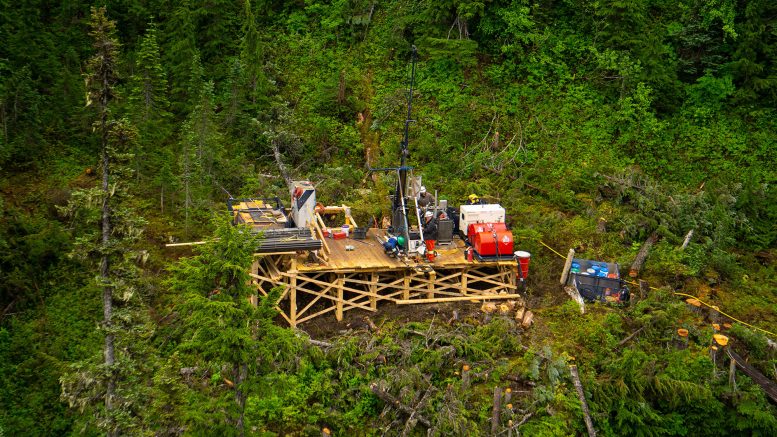Skeena Resources (TSX: SKE; US-OTC: SKREF) plans to drill a combined 89,000 metres of exploration and infill drilling before the end of the year at its Eskay Creek gold-silver project in British Columbia’s Golden Triangle and has completed 46 holes covering 24,000 metres since it restarted the drill program in July.
“In September we intend to add two more drill rigs, which will bring our rig count up to eight,” Walter Coles Jr., the company’s CEO, said in a news release. “Over the next six months, we will have a steady stream of assay results from both infill and step-out exploration holes, which should make for an exciting fall.”
Highlights from three drill holes reported on Aug. 25 include 35 metres grading 21.90 grams gold per tonne and 235 grams silver per tonne (25.03 grams gold-equivalent per tonne) starting from 80 metres in hole 20-290.

A helicopter at the Eskay Creek property. Credit: Skeena Resources.
Hole 20-274 cut 34 metres grading 5.93 grams gold and 40 grams silver (6.46 grams gold-equivalent per tonne) starting from 81 metres downhole, and hole 20-291 intersected 37 metres grading 6.52 grams gold and 25 grams silver (6.84 grams gold equivalent) from 82 metres downhole.
Both 20-274 and 20-291 validated expected resource grades and the distribution of the mineralization, the company said.
The three drill holes were also designed to test the underexplored Lower Mudstone (LM) and Even Lower Mudstone (ELM) sequences, the company noted, and led to a new discovery below the historically mined Contact Mudstone sequences below the 21A zone.
The deeper drilling in drillhole 20-290 intersected 11 metres grading 3.67 grams gold per tonne and 12 grams silver (3.83 grams gold equivalent) from 391 metres downhole, including 4 metres grading 5.99 grams gold and 20 grams silver (6.26 grams gold equivalent).
According to the company, the discovery differed from the Contact Mudstone and showed a different geochemical signature that contained no significant concentrations of the pathfinder elements mercury, arsenic and antimony.
The discovery is open for expansion along strike and up-dip and represents a target amenable to underground mining methods, the company said.
Drill holes 20-274 and 20-291 also intersected weakly anomalous mineralization in the LM sequence, the company noted, suggesting that they are a greater distance from a yet to be discovered synvolcanic feeder.
“With only three drill holes in a very limited area of the property, we have proven the geological concept model that the LM and ELM, laying below the Contact Mudstone, are mineralized by the same fluids that produced the overlying mining area, and are very prospective,” Paul Geddes, Skeena’s vice president of exploration and resource development, said in the press release.
“Our ongoing 2020 exploration program will continue to focus on synvolcanic feeder zones with an emphasis on where these feeders intersect all the mudstones, specifically the Lower Mudstones discussed here,” he added.

Skeena geologists at the Eskay Creek core shack. Credit: Skeena Resources.
The drilling also intersected additional mineralization in the Lower Mudstone below the 21A zone. Hole 20-274 cut 13 metres grading 6.49 grams gold per tonne and 11 grams silver (6.63 grams gold-equivalent) from 187 metres downhole, including 6 metres grading 11.99 grams gold and 21 grams silver (12.27 grams gold-equivalent).
The company said the mineralization is situated 50 metres below the open-pit modelled in a 2019 preliminary economic assessment (PEA), and 25 metres up-dip of a previously reported drill intersection.
The PEA envisions an open-pit mine with annual average production of 236,000 oz. gold and 5.81 million oz. silver and an estimated pre-production capex of $303 million with a payback period of 1.2 years.
The study forecast an after-tax net present value of $638 million at a 5% discount rate and a 51% after-tax internal rate of return, based on US$1,325 per oz. gold and US$16 per oz. silver.
As part of a definitive agreement announced on Aug. 4, Skeena will acquire a 100% interest in Eskay Creek and will be the mine operator. The deal, which is expected to close in the fourth quarter of this year, would lead to Barrick Gold (TSX: ABX; NYSE: GOLD) holding more than 24 million common shares of Skeena, representing about 12.4% of the junior’s issued and outstanding common shares.
Skeena will also grant a 1% net smelter return royalty on the property. Half of the royalty may be purchased from Barrick during the 24-month period after the closing of the agreement at a cost of $175 million.
Under the agreement, Skeena will make a contingent payment of $15 million, which will become active if Skeena sells more than a 50% interest in the project during the 24 months after closing.
At press time in Toronto, Skeena was trading at $2.67 per share within a 52-week trading range of 38¢ and $3.12. The company has 172 million common shares outstanding for a $458-million market capitalization.


Be the first to comment on "Skeena Resources launches aggressive drill program at Eskay Creek"